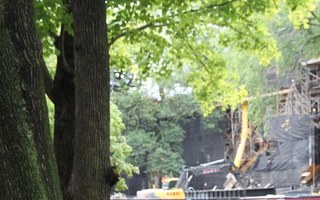In many ways, “Le Noise” finds Neil Young emulating traditional blues men. Instead of striving to reignite the rockstar sparks of his earlier career, Young takes a more reserved, stripped-down approach on “Le Noise,” distilling the full-band noise-making machine that was Crazy Horse down to its most essential components: Young’s roaring guitar and his cracked, soaring voice. Its spare instrumentation is culled from singer-songwriters, but the throbbing guitars are undoubtedly from Young’s Crazy Horse days. Young’s last two albums, while respectable, have seemed slightly irrelevant. The meandering “Prairie Wind” felt like an uninspired throwback to his Americana-folk side, while “Living With War” was a somewhat antiquated response to the Iraq War. His latest album, “Le Noise,” veers sharply away from this irrelevance, and stands as an impressive distillation of a remarkable career.
The album begins with the slow-burner “Walk With Me,” a song which sets the album’s tone. The explosive fuzz of a solo electric bursts through the speakers. Young’s voice is enveloped in a dizzying delay effect, which only accentuates his strong vocal performance. The song is interrupted by occasional feedback-interludes where Young engages his guitar’s full sonic capacities. One would expect the track’s bone-crushing thump to be accompanied by swaggering, Zeppelin-like drums, but Young’s tasteful use of feedback and his indulgent guitar playing make the song feel complete without a full band.
This aural adventuring is what makes the tried and true Neil Young-style feel new and exciting. The guitars on “Someone’s Gonna Rescue You” fizz and gurgle their way through an otherwise standard rocker. The incendiary high notes echo the melody while he anchors the track with a muddled, rhythmic drone. Though the instrumentation of the tracks is relatively spare, Young and famed producer Daniel Lanois create rich, undulating patchworks of distorted guitar, which successfully emphasize Young’s distinctive brand of noise.
Surprisingly, Lanois’s production isn’t as noticeable as it is on some of his most famous work with U2. Unlike the shimmering gloss of U2’s 1984 “The Unforgettable Fire,” with its whale-song guitars, Lanois focuses mainly on providing a richness of sound that grants every nuance of Young’s feedback its due. He frequently employs basic vocal and guitar effects, which deepen the sound, but these are always secondary to Young’s own sonic adventuring, and the album is better for it.
There are traditional singer-songwriter numbers like “Peaceful Valley Boulevard” whose dreary acoustic chords accompany Young’s rough retelling of American history. The scratched and muted strings starkly contrast the impeccable production values. The acoustic shivers delicately, and Young’s voice occasionally trails off in spiraling flights of delay, but is otherwise bare and exposed. Sonic touches like these make the album an innovative and complete take on Neil Young’s style.
The lyrics on “Le Noise” aren’t particularly memorable. They include trademark Young imagery like “winds of fate,” which can border on cliché; there are, however, some political, yet heartfelt songs like “Love and War.” It is a beautiful modernization of an otherwise typical Neil Young war-song. Lines like, “They pray to Allah and they pray to the Lord” signal Young’s desire to stay current despite his attraction to age old themes. The song eventually becomes autobiographical, with Young singing, “Sang songs about love and sang songs about war since the back streets of Toronto” and eventually concluding, “I sang for justice and I hit a bad chord, but I still try to sing about love and war.”
“Le Noise” is an effective album because it doesn’t try too hard. Neil Young isn’t desperately attempting to recapture the ragged glory of his youth, nor is he trying to reinvent himself late in his career. Instead, “Le Noise” finds him indulging in some of his most time-honored pursuits: noise-making, exploring and destructing traditional singer-songwriter themes and instrumentations. “Le Noise” is a brilliant combination of the different facets of his career, and it will easily remind fans of Young why they love him without evoking nostalgia.
—Staff writer Benjamin Naddaff-Hafrey can be reached at bhafrey@college.harvard.edu.
Read more in Arts
‘Halcyon Digest’ Revels in UnpredictabilityRecommended Articles
-
Cambridge Public Schools Superintendent Proposes Creation of Middle SchoolCambridge Public Schools Superintendent Jeffrey M. Young proposed during yesterday’s school committee meeting the establishment of a middle school in the city’s K-8 school system to close the achievement gap among different socioeconomic and ethnic groups.
-
Young Proposes Middle School PolicyAfter months of planning, Cambridge Public Schools Superintendent Jeffrey M. Young presented a short-term action plan for the system’s middle ...
-
Quincy Res. Dean Advises No Noise Complaints to HUPDQuincy House Resident Dean Judith F. Chapman sent out an email to the Quincy community this past Thursday requesting that students refrain from calling the Harvard University Police Department with noise complaints.
-
Policing PartiesIt is exceedingly clear that there ought to be formalized processes for issuing noise complaints against parties in the Houses.
-
 House Renovations Prompt Noise Complaints From Students
House Renovations Prompt Noise Complaints From Students -
MIT Leaders Lobby City Council Regarding Development in Kendall SquareMIT leaders, including President L. Rafael Reif, crowded into City Hall on Monday night to lobby the Council to support their plans for the university’s development in Kendall Square.














